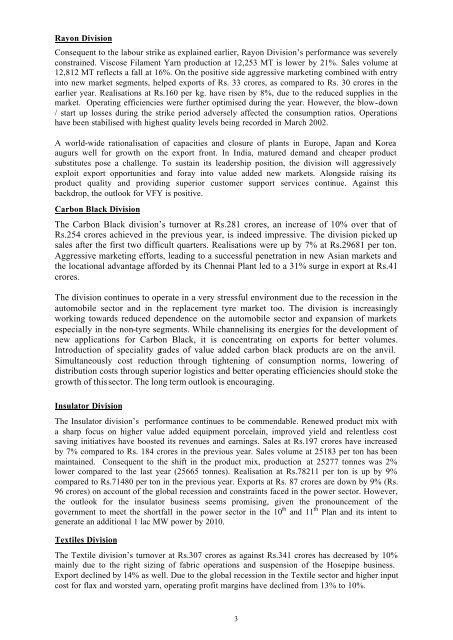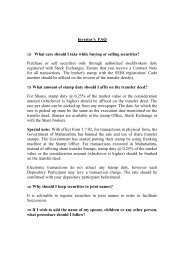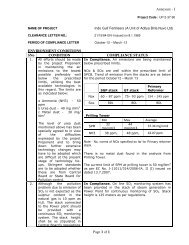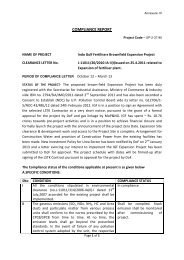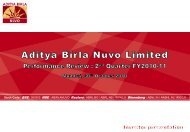IRIL Cover Sheet Results FY02 .XLS - Aditya Birla Nuvo, Ltd
IRIL Cover Sheet Results FY02 .XLS - Aditya Birla Nuvo, Ltd
IRIL Cover Sheet Results FY02 .XLS - Aditya Birla Nuvo, Ltd
Create successful ePaper yourself
Turn your PDF publications into a flip-book with our unique Google optimized e-Paper software.
Rayon DivisionConsequent to the labour strike as explained earlier, Rayon Division’s performance was severelyconstrained. Viscose Filament Yarn production at 12,253 MT is lower by 21%. Sales volume at12,812 MT reflects a fall at 16%. On the positive side aggressive marketing combined with entryinto new market segments, helped exports of Rs. 33 crores, as compared to Rs. 30 crores in theearlier year. Realisations at Rs.160 per kg. have risen by 8%, due to the reduced supplies in themarket. Operating efficiencies were further optimised during the year. However, the blow-down/ start up losses during the strike period adversely affected the consumption ratios. Operationshave been stabilised with highest quality levels being recorded in March 2002.A world-wide rationalisation of capacities and closure of plants in Europe, Japan and Koreaaugurs well for growth on the export front. In India, matured demand and cheaper productsubstitutes pose a challenge. To sustain its leadership position, the division will aggressivelyexploit export opportunities and foray into value added new markets. Alongside raising itsproduct quality and providing superior customer support services continue. Against thisbackdrop, the outlook for VFY is positive.Carbon Black DivisionThe Carbon Black division’s turnover at Rs.281 crores, an increase of 10% over that ofRs.254 crores achieved in the previous year, is indeed impressive. The division picked upsales after the first two difficult quarters. Realisations were up by 7% at Rs.29681 per ton.Aggressive marketing efforts, leading to a successful penetration in new Asian markets andthe locational advantage afforded by its Chennai Plant led to a 31% surge in export at Rs.41crores.The division continues to operate in a very stressful environment due to the recession in theautomobile sector and in the replacement tyre market too. The division is increasinglyworking towards reduced dependence on the automobile sector and expansion of marketsespecially in the non-tyre segments. While channelising its energies for the development ofnew applications for Carbon Black, it is concentrating on exports for better volumes.Introduction of speciality grades of value added carbon black products are on the anvil.Simultaneously cost reduction through tightening of consumption norms, lowering ofdistribution costs through superior logistics and better operating efficiencies should stoke thegrowth of this sector. The long term outlook is encouraging.Insulator DivisionThe Insulator division’s performance continues to be commendable. Renewed product mix witha sharp focus on higher value added equipment porcelain, improved yield and relentless costsaving initiatives have boosted its revenues and earnings. Sales at Rs.197 crores have increasedby 7% compared to Rs. 184 crores in the previous year. Sales volume at 25183 per ton has beenmaintained. Consequent to the shift in the product mix, production at 25277 tonnes was 2%lower compared to the last year (25665 tonnes). Realisation at Rs.78211 per ton is up by 9%compared to Rs.71480 per ton in the previous year. Exports at Rs. 87 crores are down by 9% (Rs.96 crores) on account of the global recession and constraints faced in the power sector. However,the outlook for the insulator business seems promising, given the pronouncement of thegovernment to meet the shortfall in the power sector in the 10 th and 11 th Plan and its intent togenerate an additional 1 lac MW power by 2010.Textiles DivisionThe Textile division’s turnover at Rs.307 crores as against Rs.341 crores has decreased by 10%mainly due to the right sizing of fabric operations and suspension of the Hosepipe business.Export declined by 14% as well. Due to the global recession in the Textile sector and higher inputcost for flax and worsted yarn, operating profit margins have declined from 13% to 10%.3


